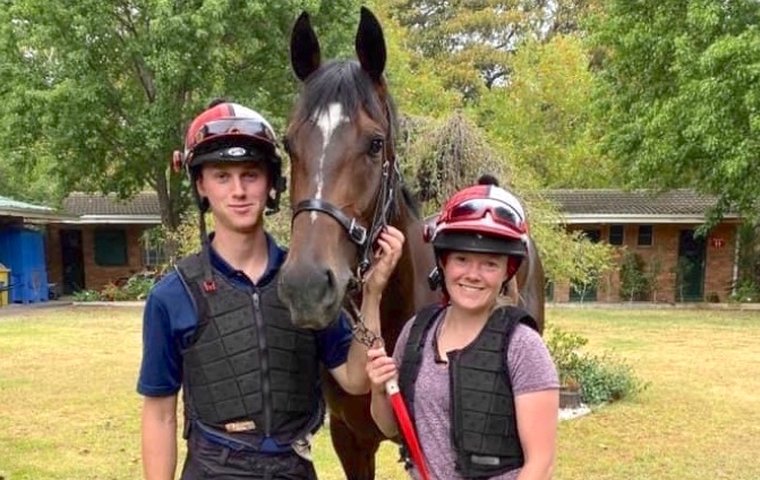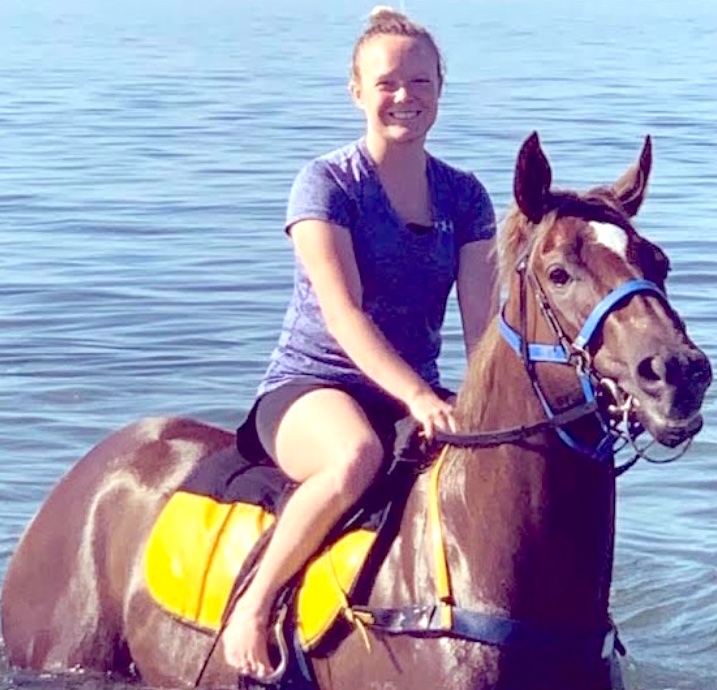
Twenty somethings Ben and Erica Rabillard are well qualified to say where the best places around the world are to work in the industry, with extensive experience already in the U.S., Britain and Australia. They gave their views to Patrick Lawrence Gilligan.
Ben Rabillard grew up in Newmarket. His father is French and works for Godolphin. After leaving school, Rabillard spent two years at the French Racing School (Ecole des Course Hippiques de Gouvieux, near Chantilly, one of five racing schools in France offering courses in all aspects of the industry for those who want to work hands-on with horses) and spent part of each week working for trainer Nicolas Clement.
After spells with Godolphin and John Gosden in Newmarket, Rabillard went to the U.S. and spent time working for Bill Mott and WinStar Farm.
Erica Herrforth is an Ohio native with a BA in Political Science from Marshall University in West Virginia. After graduating in 2016, she decided against her intended law school and instead opted to enroll at the North American Racing Academy in Lexington.
She met Rabillard when she rode out one morning for WinStar. After a winter in Ocala, Florida, working with yearlings for trainer Jimmy Miranda, Herrforth returned to Kentucky and took a job galloping horses for trainer Joe Sharp.
When Rabillard’s work visa in the States ran out in 2018, he returned to the UK, and Herrforth went with him.
After a time in Newmarket, the pair ventured to Australia – where they could both get visas to work and live together – and gained employment with top trainer Peter Snowden.
Then Covid struck, and a 6-month visit turned into two years. They could return to the States only recently, now as a married couple.
How did Australia come about?
Erica: “We knew some people in Australia, so we got working holiday visas so we could live and work together. We got jobs with Peter Snowden and his son Paul in Sydney.”
“We were supposed to return in April, but then Covid came along and neither of us would have been allowed to travel to the other’s country, so we stayed in Australia and, in September 2020, we got married.
“We were in Dubbo then, which is five hours west of Sydney. It was a condition of our visa that we do some regional work for a period of six months. We returned to Sydney after that and stayed there until we returned to the States on September 3.”
How did the different countries compare?
Ben: “I Iove Newmarket, being on the gallops, and I have also spent two years in Chantilly. But, of anywhere, maybe the best vibe is in the UK. The Guineas meet, Royal Ascot, Glorious Goodwood - it creates such a buzz. You can pick up the Racing Post anywhere, from a village shop at the tip of Scotland to the center of London.
“I really enjoyed Randwick in Sydney and how they train on different tracks. They would train in the opposite direction once a week. They can also school them over hurdles to sharpen their minds. The grandstand at Randwick was fine, but they only have tie-up stalls for the horses at the track on race day.”
Erica: “I was lucky enough to be in the winner’s enclosure after Stradivarius won at York and that was very exciting. People get very caught up in it all in the UK.
“Every country has adapted their training routines to the facilities available to them. Australia had sand and Polytrack, Newmarket has the hills. In the U.S., it is mainly just the dirt oval. I like the synthetics best. I feel you can feel how they are moving better on synthetic.

“In Australia, horses are often trained both ways around the track on different mornings. I found out then galloping clockwise that my muscles weren’t developed to go the other way. My right side had to get a lot stronger, and that made think about how just training the horse in one direction could be leaving them weaker in some ways doing that.
“My favorite training regime though is still the States, although the horsemanship of riders is highest in the UK.
“In Australia, they gallop very steady, hardly more than a jog in the mornings, maybe up to two miles, and then maybe three times a week they might do a three-quarter speed for half a mile a few times week. They would use the sand and the Polytrack.”
Do Australians do much hill work?
Ben: “There are some trainers away from the big training centers who use hills in Australia, but all the big successful trainers train at the track, and very steady canters is their thing. It wasn’t easy. It made the horses pull very hard.
“Everything every day is to the clock there. Every rider has a bleeper to count each furlong. They are very strict about it in Australia.
“I struggled with it, going so steady. I found you had to stay on their mouths and afterwards they were quite agitated. They wouldn’t walk home relaxed. Maybe it was sometimes too much about the clock and not enough about the individual.
“I find Europe seems to have a good approach with horsemanship and there is more time taken with the horses. Alain de Royer Dupre [in France] always believed every horse must be trained as an individual. I think it is easier to do that in Europe, but good trainers find a way everywhere.”
What did you learn on your travels?
Erica: “I think more Americans should travel and work in this industry and learn different ways to do things. This is a job you can travel the world and find work in the industry.
“I don’t think Americans realize how attainable it is, and we tend to be quite inward-looking. People all over the world want riders, and you grow as a person in every different country and you gain new skills and ideas of how to do things. It was quite amazing and eye-opening to do.”
Ben: “I think traveling has broadened my outlook. It improves your horsemanship and you pick up dos and don’ts. It gives you perspective on how you might train yourself, learning different methods and strategies. I’ve picked up a lot on training sprinters, about keeping horses fresh.
“Maybe one thing the Australians use more than anywhere else is turnout time for the horses in paddocks. They call it ‘preps’ to keep the horses feeling good and to keep their mind good. The time-out periods are listed in the form book.”
Erica: “I think traveling has made me more adaptable. Before I travelled, I thought there was just one way to do things, and one way to ride them. So I learnt a lot from that.
“I’m biased, but I love the racing in the States, although it was difficult to judge the racing experience in Australia because of Covid, without spectators for the most part.”
How would you compare the working environments in different countries?
Erica: Stable staff experience different conditions in the different countries. In the UK and Australia, there are rules for holidays, for stake money, and they are paid to take their horses racing. So staff know what to expect, whereas, in the States, it really depends on the trainer.
“I think that may be partly because of historically being manned by so many ethnic minorities here, and that might have to change if we want to encourage younger U.S.-born workers to enter the industry.
“I think racing jurisdictions should put their heads together all around the world and take the best of everything from each country. Then every racing nation could really raise the bar. Racing could evolve more.”
Ben: “Financially and hours worked, Australia does it right. Staff have proper representation, problems get taken care of, all overtime worked is properly paid, there are paid vacations and public healthcare, sick pay, and your stakes money is guaranteed.
“Australia and France have great funding models, as does the States. The UK definitely does not, and yet many backstretches in Australia and even some in the States need money spent on them.
“Traveling has broadened our horizons. We have come across a lot of great horsemen and women, and we found a lot of great horse people everywhere, but perhaps for me France is the place where classic traditional racehorse training with old fashioned horsemanship remains the purest.”
Erica: “There is always extra work to be done at the track. I would walk horses in the afternoon and braid horses for the races, so you can always earn extra money.
“If horseracing wants more young Americans to enter the industry, though, some standards for pay and conditions maybe should be imposed. It is a very exciting industry to work within, way more fun than working for a fast-food company, but those companies offer very clear pay-and-conditions policies.
“America as a whole needs to catch up with the times, not just in horseracing. We need more Americans on board in racing, not just as trainers or employees, but the general public as well to be on board with the sport.
“It would be good to have more young American riders and grooms joining the industry.”


